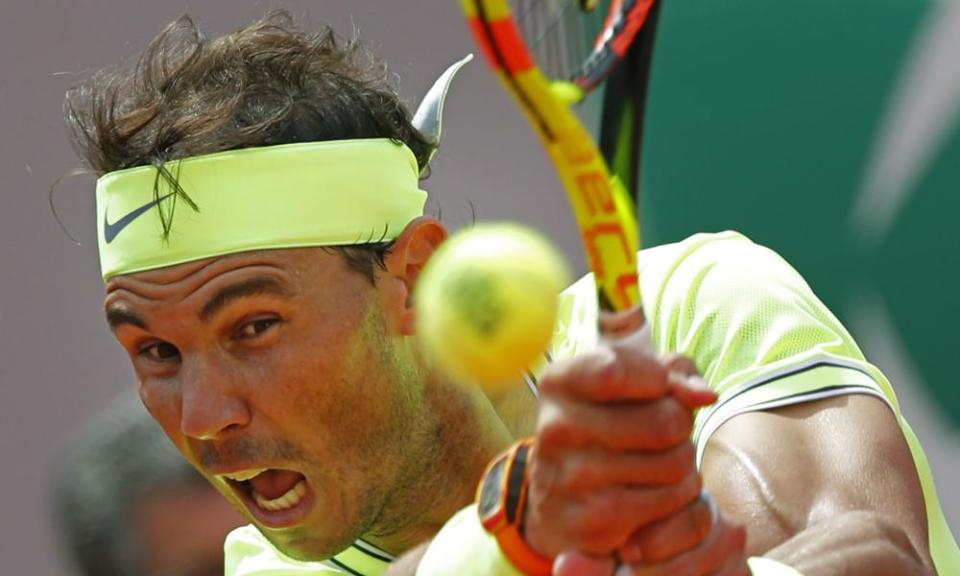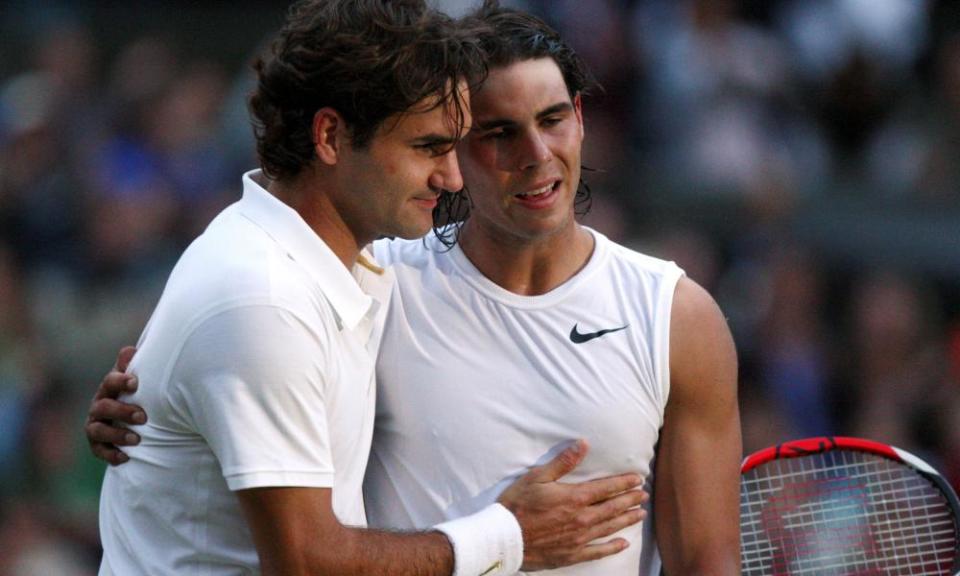The greatest: Rafael Nadal – mental and physical giant with a brutal forehand

There are many images that stand out with Rafael Nadal. The lasso-like forehand that has wreaked havoc throughout his career; the pirate shorts and sleeveless shirts of his youth; the tics of his pre-serve routine; the forensic placement of his water bottles; the joyous fist-pumps and yells of “Si!” after another sensational winner.
But one thing sticks in the mind above all: his attitude. There has never been a moment when you could say Nadal has not given everything he had to try to win. Even Roger Federer has the odd day when his heart doesn’t quite seem in it. Nadal has rarely had a single point.
Carlos Moya, the former world No 1, a long-time friend and now his coach, first met him when Nadal was 12. “I could see, by the sheer intensity with which he trained, that he was super-ambitious and desperate to improve,” Moya said in Nadal’s book, Rafa. “He hit every shot as if his life depended on it. I’ve never seen anything like it, not even close.”
Related: The greatest: Roger Federer – balletic grace that makes the outrageous appear effortless
The intensity. The concentration. The focus. The belief. From the moment he broke through in 2003, Nadal’s laser-like focus and ability to dig deeper than most was obvious, as big a weapon as his forehand, which itself is one of the most devastating shots in tennis history, a shot Andre Agassi described as “just brutal”.
It was Toni Nadal, his coach and uncle, who pushed him to extremes in training as a child, building up mental strength through adversity. “He always stressed the importance of endurance,” Nadal said of Toni in his autobiography, Rafa: My Story. “Endure, put up with whatever comes your way, learn to overcome weakness and pain, push yourself to breaking point but never cave in. If you don’t learn that lesson, you’ll never succeed as an elite athlete”. That is what he taught me.”
When Nadal won his first French Open title in 2005, Toni named a number of other Spanish players, such as Moya, who had won only one grand slam title, and asked his nephew if he wanted to be like them. With 19 to his name now, one behind Federer, Nadal could yet end up top of the pile.

And to think that there were some who said he could only play on clay. By the time he had turned 25, Nadal had added an Australian Open title, two Wimbledons and one US Open, to go with the five Roland Garros titles he had already collected. From being a player who could win through his speed and resilience, he adapted to faster surfaces, standing closer to the baseline, bullying opponents off the court with his club of a forehand, backed up by an underrated backhand, superb movement, deft touch at the net and that incredible will to win.
In 2005, Federer was well-established as the world No 1. But even as he dominated the Tour in 2006 and 2007, winning six of the grand slams on offer, Nadal dominated their head-to-head battles, winning six of their first seven meetings, two on hard courts.
I expect to play my best on every point and fight for every point like it is the last one. I just fight point by point
Rafael Nadal
And then there was clay. There has surely never been a mudlark like Nadal, a man with the physical strength, mental strength and clay-court nous to succeed on that most demanding of surfaces, year after year. Watching Nadal on clay is like witnessing an art form, an unstoppable force. His record of 12 French Open titles will surely never be beaten, except when he breaks his own mark with his next one.
Paul Annacone, who coached Federer from 2010 to 2013, saw Nadal close up and at his devastating best, on several occasions. For Annacone, too, it was the attitude, not just the tennis, that made him so great. “It is the relentless ability to play every point like nothing else matters except that point,” he told the Tennis Channel. Nadal, speaking after winning his second Wimbledon title in 2010, said his ethos is simple. “I expect to play my best on every point and fight for every point like it is the last one. I don’t think if the match is going to be difficult. I just go on court and fight point by point.”
Related: The greatest: Novak Djokovic – speedy superserver who masters mind games
The effect his attitude has had on his rivals is just as important. Federer had to change his game. The current world No 1, Novak Djokovic, said in a recent Instagram chat with Andy Murray: “His intensity, especially when you see him jumping around before you walk on to the court, it already intimidates you. It creates the challenge in your mind that I’m going in with a gladiator ... a mental giant and also a physical giant. I think he was the most injured of any of us. I think he had something every second season for several months and managed to come back and build his game. The resilience he has on the court was astonishing.”
Nadal has played Djokovic 55 times, with the Serb shading their head-to-head record 29-26. In 40 meetings with Federer, Nadal has won 24, including that incredible Wimbledon final in 2008 when he proved he could play on grass as well as clay. He remains, as Djokovic says, a mental giant. And he’s not done yet.

 Yahoo Sport
Yahoo Sport 





































